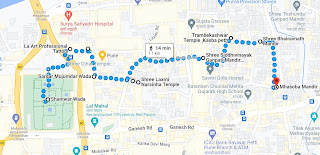No, I am not in North Africa or Arabia, but in historic Pune, the seat of Maratha Power. The Kasaba in Pune predates its eminence maybe by a thousand years, perhaps less. The Arabic and Turkish meanings differ somewhat, but not by too much -
A kasbah (, also ; Arabic: قَـصَـبَـة, romanized: qaṣaba, lit. 'fortress', Arabic pronunciation: [qasˤaba], Maghrebi Arabic: [qasˤba]), also spelled qasba, qasaba, or casbah, is a fortress, most commonly the citadel or fortified quarter of a city.[1][2][3][4] It is also equivalent to the term alcazaba in Spanish (Spanish: [alkaˈθaβa]), which derives from the same Arabic word.[5][6] By extension, the term can also refer to a medina quarter, particularly in Algeria. In various languages, the Arabic word, or local words borrowed from the Arabic word, can also refer to a settlement, a fort, a watchtower, or a blockhouse.
In Turkish and Urdu the word kasaba refers to a settlement larger than a village but smaller than a city; in short, a town. In Serbo-Croatian, kasaba (Cyrillic: касаба) means an undeveloped, provincial small town. In India, a qasbah is a small town distinguished by the presence of Muslim families of rank.[18]
The Kasaba in Pune was likely a settlement larger than a village. Chinmay Datar's blog does an awesome job of showing what Pune's geography looked like over the years - one of his images below for easy reference, but do read his post for a highly detailed description.
We however are focusing this on a romanticized version of the past which more than likely appeared mundane to the denizens of that time.
Apologies for using multiple images, but Google Maps can only do 10 stops at a time and any area of historical significance in Pune, even if less that one square kilometer has many more.
As it must, all roads lead to and from Shaniwar wada (शनिवार वाडा) - our route starts off by taking in the view of the steps leading to the old wall protecting the city.
A domestic worker hurried along to her job, perhaps entirely oblivious to the history. We tend to value what's lost in the sands of time, but do people so focused on their quotidian chores in the present really care? Most likely not.
The closest landmark to these historic steps is now a tattoo parlor - signs of a city rapidly blending it's past, present and the future. From this tattoo place, just changing the angle and turning your back to the Shaniwar Wada, you see more reminders of a glorious past gone by.
If you walked down this street some three hundred years ago, you would have seen grand houses (वाडे) with majestic entrances and ornate wooden balconies sporting exquisite carvings belonging to the hoi polloi, just like the one here on the left. Oh what a walk it must have been - no less than London or Paris in the nineteenth century.
And then a sudden reminder of an empire lost to the western marauders. This collapsed house right next door where the owner didn't even have time to get his teacups off the wall. And the most surprising, the fragile teacups remaining intact.
The western marauders left in 1947, but left it open for more destruction by the local ones. Would it have killed the administration to mandate that all new buildings must maintain old facades? I can only imagine what we are missing.
Turn your backs here and now you are facing possibly the oldest inhabited street in Pune - Sardar Mujumdar Lane.
An erstwhile nobleman built an enormous residence for himself that is still being lived in by his descendants. Mind you, being Indians, people still took photos even when there was a board prohibiting that and the lady of the house excoriated the photographers for being Indians. I of course being smarter than the rest took photos only after she had departed from the scene.
Along the way, more temples, and a stop at
Ram Ganesh Gadkari's residence when he was a student at Fergusson College. He didn't do well, but boy could he write and left behind a huge legacy of poems, plays and essays. Known as Maharashtra's Shakespeare, his poor bust in a garden faced an unforeseen emergency - the less said about that is the better.
Next up, the old temple of the New Kalbhairav (काळभैरव) - with a Yadav period lotus on the stone masonry, is now airconditioned. Perhaps the heat is too much these days. An old wooden post serves as a reminder of the horrific bagad (बगाड) ritual practiced even today elsewhere.
The best thing one saves for the last and I will leave you with this. Ancient shiva linga of Kedareshwar (केदारेश्वर), possibly a thousand years old, has seen it all, from being smuggled away from its seat along the old Ambil Odha in the middle of night to Kille Purandar to save it from certain destruction at the hands of Shahistekhan's soldiers to being reinstalled in a different location at a later date returning to preeminence.
Three pages from the Pune city research news - book two (पुणे नगर संशोधनवृत्त - खंड २) blends in the Arabic with Marathi, spelling out a grant of land and oil to the priests of Kedareshwar - framed on the walls of the temple. Most certainly seems strange to our eyes accustomed to seeing only Arabs being named this way.
सिके वेदमूर्ती रामभट व कृष्णंभट बिन कोडभट व गंगाधरभट व सदासिवभट बीन नागेशभट इब्न यादवभट बिन आनंतभट ...




.jpeg)







Comments
Post a Comment